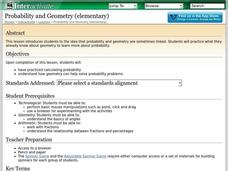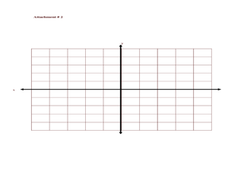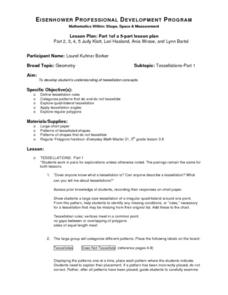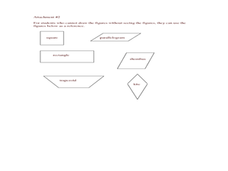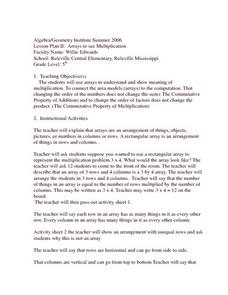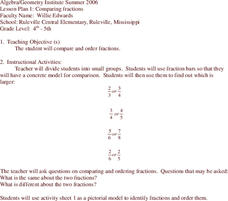Shodor Education Foundation
Sets and the Venn Diagram (Beginner)
Venn diagrams are helpful in understanding the idea of a set and using attributes to sort items. This basic plan is an introduction with an added bonus of an applet that can be used to demonstrate the activity. If a classroom of...
Curated OER
Probability and Geometry
Learners examine the relationship between probability and geometry to solve problems. In this geometry and probability lesson, students investigate the effect of changing percentages on a spinner to the probability of landing on a...
Curated OER
Mathematics Witing: Algebraic Processes and Its Connections to Geometry
Students, using manipulatives, determine how many different ways there are to arrange 3 and 4 objects. They organize and record their arrangements. Students investigate the pattern generated by 3 and 4 objects, they predict how many ways...
Curated OER
Mathematics Within: Algebraic Processes and Its Connections to Geometry
Students analyze multiple strategies of multiplication: clustering, area model, breaking apart/decomposing, etc. They create their own strategies to approaching multiplication problems and share them with their classmates. Discussion...
Curated OER
Battle Shapes
Fifth graders play Battleshapes which is a variation of Battleship with geometry. In this geometry lesson, 5th graders get a graph paper with four quadrants. They call out coordinate points and attempt to sink their opponents shapes.
Curated OER
Plain Figures and Measuring Figures
Students investigate basic geometric concepts. In this geometry lesson, students explore solids through measuring and modeling. This assignment models the importance of understanding concrete objects in geometry.
Curated OER
Conjectures and Conclusions
Students draw conclusions and make conjectures given a specific scenario. In this geometry lesson plan, students model real life scenarios using properties of triangles. They model number facts and explain why the outcome is what it is.
Curated OER
Geometry /Tessellations
Middle schoolers investigate the concept of tessellations and how they are formed using angles. They categorize how different patterns do and not tessellate and separate them into two different places for assessment. The teacher draws...
Curated OER
Exploring Area
Fifth graders explore the concept of area using the geometry of selected objects. The laboratory for this experience is the classroom. The lesson focuses upon the objects that have four sides like squares and rectangles.
Curated OER
TAAS Attack Daily Upkeep #7
In this word problem worksheet, 5th graders review various mathematical terms by selecting the correct letter that answers each question completely. There are a total of 13 math problems to solve which vary between word problems,...
Curated OER
What's Your Angle
Students create an original lesson about geometry and angles. In small groups they take pictures using a digital camera of obtuse, acute, right, and straight angles that they find at school. Students use the photos in a computer...
Curated OER
Linear and Locomotor Movements
Students develop locomotor movements. In this dance movement lesson, students identify lines and develop creativity while performing to "Cha Cha Slide". Students discuss how to create dances and difficulty of movements.
Curated OER
Shapes
Fifth graders explore shapes. They recognize and name two-dimensional and three-dimensional shapes. Pupils discuss the properties and criteria for each shape they find in real life and construct a Kid Pix project using pictures of the...
Curated OER
Recognizing Patterns
Students explore the concept of patterns. In this patterns instructional activity, students use applets to manipulate tessellations. Students predict the next number in a sequence by recognizing patterns.
Curated OER
Pascal's Patterned Triangle
Fifth graders receive a brief history of Pascal's triangle. As a class the students construct the first few rows of the triangle. The students are then split into groups where they finish a worksheet identifying the total value of each...
Curated OER
Pie Graph
Fifth graders examine fractional parts of pie graphs. Given a bag of M&Ms, 5th graders interpret the data. They use a paper plate and colors to create a graph of the types of M&Ms represented.
Curated OER
Working with larger arrays
Fifth graders use arrays to show the meaning of multipication in selected situations. They practice using large and small arrays. The lesson has numerous activities, which gives students more opportunities to display academic growth.
Curated OER
Measurement
Fifth graders measure specified distances when given perpendicular lines. In this measurement lesson plan, 5th graders draw the lines themselves.
Curated OER
Quadrilateral Clues
Fourth and fifth graders work in pairs explore quadrilaterals. In this problem-solving lesson, learners participate in hands-on activities that require them to identify, describe, compare, and classify quadrilaterals. This is meant...
Curated OER
Mathematics Within: Shape, Space & Measurement
Students experiment and analyze triangulation to assess degrees of combined angles, predict polygons that tessellate as well as extending of shapes to create tessellations. They explore the concept of why some polygons tessellate when...
Curated OER
Area and Perimeter of Rectangles
Discover the difference between area and perimeter. Learners are grouped in twos and threes and each group has one advanced/gifted learner to serve as the peer helper. They receive manipulatives to help them determine the area and...
Curated OER
What's Your Line?
Fifth graders collect temperature readings over a period of time, enter the information into a spreadsheet and choose the appropriate graph to display the results.
Curated OER
Arrays To See Multiplication
Fifth graders examine multiplication. They construct arrays to demonstrate specific multiplication facts. They identify examples and non-examples of arrays. Students use counters to model the commutative property of multiplication.
Curated OER
Comparing Fractions
Students investigate concepts of working with fractions. They compare different fractions and put them in chronological order. The quantities are compared as either being larger or smaller also.



